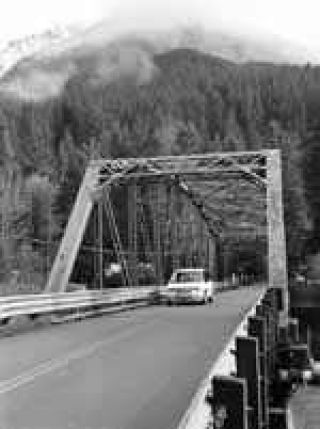NORTH BEND – It’s old, it’s narrow, and it’s patched up like a quilt, but after 97 years – 46 of them spanning the Middle Fork of the Snoqualmie River – the Mount Si Bridge continues to move vehicles from bank to bank.
But that could change because the King County Department of Transportation Road Services Division wants to build a new bridge, one that’s wider and stronger and better able to meet the needs of a growing community.
On April 4, the Road Services Division held an open house at Opstad Elementary School that provided details to five proposed locations for a future bridge, and it allowed residents to talk with county officials working on the bridge-replacement project.
Some current deficiencies with the Mount Si Bridge, according to the Road Services Division, are that: It’s too weak to support heavy trucks; it’s too narrow; it’s too low for tall trucks; and the bridge is at the end of its useful life.
The Mount Si Bridge was constructed in 1904 and crossed the White River near Buckley. In 1955, it was taken apart and erected at its present location. Now a registered county landmark, the bridge is significant because of its use of Parker-struss design and because it uses pin connections instead of rivets, according to a 1995 King County historic-bridge inventory. The bridge was the subject of a seismic retrofit in 1997.
Gwen Lewis, Mount Si Bridge Replacement Project manager, said because of its age, the bridge is inspected yearly and requires a high level of maintenance. After conducting an assessment, officials decided they wanted to take the bridge out of the county’s transportation network and build one suitable for today’s needs.
“It was built for Model Ts and we’re in the year 2001,” she said of the Mount Si Bridge.
The Road Services Division has secured a federal grant, which will be administered by the state of Washington, to replace the Mount Si Bridge. Lewis said because of the grant, the federal government will pay 80 cents for each dollar spent on a new bridge.
At the open house, a drawing of the proposed new bridge provided a glimpse of what it might look like. It featured 12-foot lanes, instead of the current 9-foot lanes, with 8-foot shoulders and used girder construction.
Five alternative locations have been offered for the proposed bridge. Three of the locations are where the bridge now sits, while two others are further upstream.
Alternative 1 would involve building a new road north from the intersection of North Bend Way and 436th Avenue Southeast, placing the new bridge across the Middle Fork and connecting the road to the Mount Si Road east of 439th Place Southeast. Alternative 5 would go from Southeast Tanner Road, across the Middle Fork, to 452nd Avenue Southeast.
County officials say the new bridge would better serve the needs of the approximately 1,400 residents living north of the Middle Fork, who sometimes cannot get to and from work or home because of bridge closures. And it would help keep traffic flowing as more and more people move into the area.
More than 1,800 vehicles drive north across the bridge each day, while more than 1,700 drive south. By 2025, the county projects those numbers to increase to more than 4,400 vehicles driving north across the bridge each day, and more than 4,200 driving south.
Commissioners with King County Fire Protection District 38 say it’s because people are moving into the area north of the Middle Fork that the Mount Si Bridge should be kept, which would give the fire district another route to reach residents’ houses.
“From a public-safety viewpoint, King County has a unique opportunity to enhance the existing level of access to this area by leaving the current bridge intact and constructing the new bridge in a different location,” wrote commissioners Ronald Pedee, Gary Stevens and William Weber in a letter to the county.
Bob Cokewell, who lives southeast of the Mount Si Bridge, agreed that it should be kept as an access point for emergency personnel, and he questioned whether it would be cheaper in the long run to remove the bridge.
“Tearing that bridge down is going to be very expensive, especially over a fishing stream,” he said.
Lewis said the county is far from making a decision on whether to tear down the Mount Si Bridge.
“Anytime we have a historical structure, taking down the bridge is the last thing we want to do,” she said, adding that the county would try to market the bridge to another organization or group willing to take on its upkeep.
Lewis said a final decision concerning the location of the new bridge and its design will not be made for quite some time, and she encouraged local residents to send in their comments and opinions, which would be incorporated into a final plan of action.


